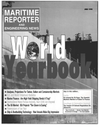
Page 79: of Maritime Reporter Magazine (June 1998)
Read this page in Pdf, Flash or Html5 edition of June 1998 Maritime Reporter Magazine
COATINGS & CORROSION CONTROL ciency (more paint gets to the sub- strate instead of being wasted).
This may also reduce overall sol- vent emission, as well as the quan- tity of paint required. This tech- nique is typically used on more complex parts or in areas where overspray could be detrimental to machinery or other operations.
HVLP also reduces the amount of masking of adjacent surfaces. It generally has a lower production rate than conventional air or air- less spraying.
Shipyards in northerly climates such as Bath Iron Works (Bath,
Maine) often have a need to apply low VOC coatings in cold weather.
One new piece of equipment is a portable heated and insulated storage cabinet. These maintain the coating at temperatures near 72°F (20°C) at location immediate adjacent to where the coating is applied. Bath Iron Works recently purchased 15 such cabinets at $8,000 a piece.
In warmer climates where freez- ing is not common, water-borne coatings are another alternative for reducing VOCs and HAPs.
Avondale Shipyards converted its two pre-construction primer lines from inorganic zinc (zinc silicate) to a waterborne epoxy acrylic. The epoxy acrylic has reduced VOC (less than 240 g/1 [2 lbs/gal]).
Volatile coalescing aids are still needed in the formulation to ensure adequate film forming properties. Water-borne coatings also have simplified cleanup and no regulatory restrictions on thin- ning. The two-part system used at
Avondale requires a 9:1 ratio of resin to curing agent. The resin is supplied in 1,000 liter containers.
Powder Coatings
One approach adopted by Bath
Iron Works, Electric Boat (Groton, (3 A LONG EXPERIENCE IN STIFF BOOM - TELESCOPIC
BOOM - KNUCKLEBOOM
HEAVY DUTY CRANES F
FROM 2,5 TO 250 TM
THE WIDEST RANGE
OF MARINE CRANES 'Ms-f-:. r.r ••T :r ! - :"" - f^-^*^
WORLDWIDE SALES &
SERVICE NETWORK
EFFER' S.p.A. Marine Division - Via Bonazzi 12/14 - 40013 Caste
FOR INFORMATION CALL US NOW
Ph. +39 51 700179 - Fax +39 51 6325115
Circle 148 on Reader Service Card
MARINE PROPULSION INC » LOHMAN & STOLTERFOHT - Marine Gears, Clutches and Torsional Couplings » MAR-PROP THRUSTERS - 100 - lOOO HP Tunnel Thrusters » HEIMDAL - Controllable Pitch Propellers - Marine Gears » KORT PROPULSION LTD. - Nozzles - Propellers »NORGEAR - Auxiliary Gear Drives • INTERNATIONAL POWER EQUIPMENT CORP. - SCR Drives and Controls • AISCO - ABS Class Drive Lines
COMPLETE TURNKEY SYSTEMS
SALES, PARTS, SERVICE
Marine Propulsion Inc. 1505 Corbin Ave .Hammond, LA 70403
Tel. 504-542-5344 • Fax: 504-542-5347 www.marinepropulsion.net • e-mail:[email protected]
Conn.) and others, is the use of powder coatings, which have zero
VOCs and HAPs. The powder is electrostatically sprayed to a heat- ed metallic substrate. The heat causes the powder to melt or fuse.
The most commonly used are ther- mosetting epoxies (two compo- nents reacting together). There is some use of single component ther- moplastic (e.g., polyester). The
U.S. Navy has developed specifica- tions for powder epoxy (MIL-C- 24712). Also some commercial products are permitted by the
Navy. Presently, powders are used almost primarily for small parts because of the need for ovens.
Parts coated include hangers, brackets and casings. A submarine may contain several thousand hangers according to Mark
Panosky of Electric Boat, which is conducive to an automated powder coating process. In addition to eliminating VOCs, powder also reduces production time because of the rapid cure and the ability to apply 200 micrometers (8 mils) or more in one coat. Automated pow- der coating facilities require a sub- stantial capital investment (typi- cally $300,000 to $500,000).
However, the payback is often achieved in five years or less due to reduced labor costs and the improved efficiency of the auto- mated powder coating process.
Training
As with any new technology, the applicators must be trained and become experienced with these dif- ferent materials and their applica- tion properties.
At Electric Boat, the yard had established a regular training pro- gram for applicators, so the transi- tion was not difficult. However, the applicators must learn to not rely on thinners to adjust viscosity.
Bath Iron Works has emphasized the need for training painters on proper use of the new materials as they are introduced. For the U.S.
Navy yards, less funding has been available for training of painters.
This has required greater atten- tion by the supervisors and inspec- tors to ensure proper application
One important difference with the new coatings is that thinning is severely restricted, as thinning may cause the coating to become non-compliant. Applicators must understand the reason for this lim- itation and be better skilled in selecting and adjusting the spray equipment. In the past, the viscos-
Circle 298 on Reader Service Card

 78
78

 80
80
